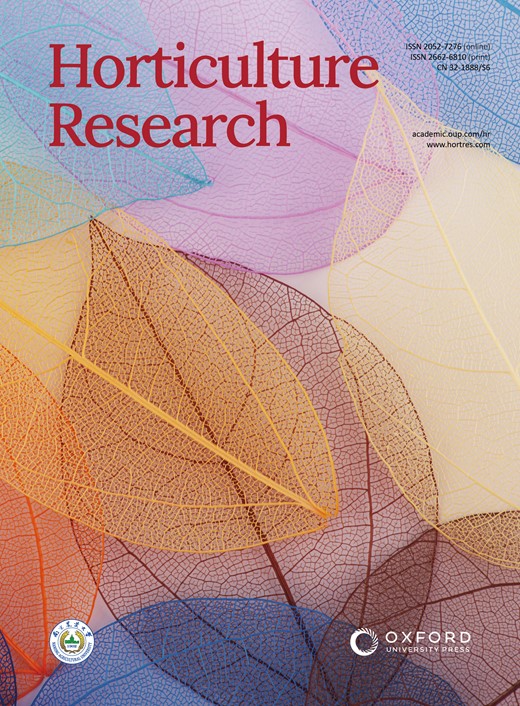大白菜嫩梢开花调控和春化的单细胞转录组分析
IF 8.7
1区 农林科学
Q1 Agricultural and Biological Sciences
引用次数: 0
摘要
在大白菜的生长发育过程中,嫩枝顶端活动与春化之间的相互作用对开花时间至关重要。目前还不完全清楚大白菜嫩枝顶端分生组织中各种细胞类型之间错综复杂的关系及其在调控开花基因表达中的作用。要深入了解大白菜先端分生组织中的单细胞类型及其对开花基因和春化的影响,就必须对其进行全面分析。我们的研究首先建立了大白菜非春化 25 天后的单细胞转录组图谱。通过分析 19 602 个单细胞,我们利用已建立的标记基因将它们区分为 15 个不同的细胞群。我们发现,芽尖发育和开花的关键基因主要存在于芽分生细胞(SMC)、伴生细胞(CC)和叶肉细胞(MC)中。在 CC 中观察到了抑制开花的 MADS-box 蛋白 FLOWERING LOCUS C 2 (BrFLC2),这与拟南芥中发现的模式一致。通过绘制SMC、CC和MC的发育轨迹图,我们阐明了芽顶发育和开花过程中关键基因的进化途径。通过创建春化条件下大白菜芽尖的单细胞转录图谱,我们发现已知开花基因的表达发生了明显的变化,如变性无敏感性3(VIN3)、变性1(VRN 1)、变性2(VRN 2)、BrFLC和FLOWERING LOCUS T(FT),这些基因的表达因细胞类型而异。我们的研究强调了单细胞 RNA 测序(scRNA-seq)在揭示大白菜嫩梢复杂的分化和春化过程方面的变革性影响。这些见解对于加强这种重要蔬菜的育种策略和栽培管理至关重要。本文章由计算机程序翻译,如有差异,请以英文原文为准。
Single-Cell Transcriptomic Analysis of Flowering Regulation and Vernalization in Chinese Cabbage Shoot Apex
Chinese cabbage development, the interplay between shoot apex activity and vernalization is pivotal for flowering timing. The intricate relationship between various cell types in the shoot apex meristem and their roles in regulating flowering gene expression in Chinese cabbage is not yet fully understood. A thorough analysis of single-cell types in the Chinese cabbage shoot apex and their influence on flowering genes and vernalization is essential for deeper insight. Our study first established a single-cell transcriptomic atlas of Chinese cabbage after 25 days of non-vernalization. Analyzing 19 602 single cells, we differentiated them into 15 distinct cell clusters using established marker genes. We found that key genes in shoot apex development and flowering were primarily present in shoot meristematic cells (SMC), companion cells (CC), and mesophyll cells (MC). The MADS-box protein FLOWERING LOCUS C 2 (BrFLC2), a gene suppressing flowering, was observed in CC, mirroring patterns found in Arabidopsis. By mapping developmental trajectories of SMC, CC, and MC, we elucidated the evolutionary pathways of crucial genes in shoot apex development and flowering. The creation of a single-cell transcriptional atlas of the Chinese cabbage shoot apex under vernalization revealed distinct alterations in the expression of known flowering genes, such as VERNALIZATION INSENSITIVE 3 (VIN3), VERNALIZATION 1 (VRN 1), VERNALIZATION 2 (VRN 2), BrFLC, and FLOWERING LOCUS T (FT), which varied by cell type. Our study underscores the transformative impact of single-cell RNA sequencing (scRNA-seq) for unraveling the complex differentiation and vernalization processes in the Chinese cabbage shoot apex. These insights are pivotal for enhancing breeding strategies and cultivation management of this vital vegetable.
求助全文
通过发布文献求助,成功后即可免费获取论文全文。
去求助
来源期刊

Horticulture Research
Biochemistry, Genetics and Molecular Biology-Biochemistry
CiteScore
11.20
自引率
6.90%
发文量
367
审稿时长
20 weeks
期刊介绍:
Horticulture Research, an open access journal affiliated with Nanjing Agricultural University, has achieved the prestigious ranking of number one in the Horticulture category of the Journal Citation Reports ™ from Clarivate, 2022. As a leading publication in the field, the journal is dedicated to disseminating original research articles, comprehensive reviews, insightful perspectives, thought-provoking comments, and valuable correspondence articles and letters to the editor. Its scope encompasses all vital aspects of horticultural plants and disciplines, such as biotechnology, breeding, cellular and molecular biology, evolution, genetics, inter-species interactions, physiology, and the origination and domestication of crops.
 求助内容:
求助内容: 应助结果提醒方式:
应助结果提醒方式:


